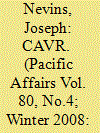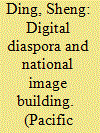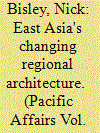|
|
|
Sort Order |
|
|
|
Items / Page
|
|
|
|
|
|
|
| Srl | Item |
| 1 |
ID:
082600


|
|
|
|
|
| Publication |
2008.
|
| Summary/Abstract |
This article provides an overview of, and analyzes, how the final report of East Timor's Commission on Reception, Truth and Reconciliation (CAVR) treated matters of responsibility for gross human rights abuses, accountability and reconciliation. While the article acknowledges the value of the report, it highlights Chega!'s limitations. The CAVR did not go as far as it could and should have in analyzing responsibility for atrocities and recommending amends. In making this argument, this article moves beyond relatively conventional analyses of reconciliation that focus on individuals and their attitudes, values and beliefs, and overlook collective and material forms of violence and injustice. Instead, it focuses on state actors, particularly those beyond Indonesia, who aided and abetted Jakarta's crimes, while advocating a wide-ranging analysis and repair of the associated damage. In doing so, the article contends that reparations for the damage must go beyond the immediate conflict so that those persons, groups or institutions whose privilege in part derived from East Timor's victimization also provide amends. It thus champions the notion that reconciliation and redistributive justice are inextricably linked
|
|
|
|
|
|
|
|
|
|
|
|
|
|
|
|
| 2 |
ID:
082602


|
|
|
|
|
| Publication |
2008.
|
| Summary/Abstract |
In the global information age, the Chinese diaspora has been empowered by information and communication technologies, and is increasingly involved in China's politics and foreign policy. This article examines the role of the Chinese digital diaspora in Beijing's national image-building efforts, in the context of China's rise to the status of a global power. While the digital diaspora has helped strengthen China's international broadcasting power and has contributed to establishing a favourable national image, the increasing opportunities for communication and building connections can expose a "real China" to the outside world, and have harmful effects on China's image. This article argues that the Chinese digital diaspora represents a double-edged sword
|
|
|
|
|
|
|
|
|
|
|
|
|
|
|
|
| 3 |
ID:
082601


|
|
|
|
|
| Publication |
2008.
|
| Summary/Abstract |
This article examines the current state of East Asia's regional architecture with a focus on efforts to construct an East Asian Economic Community (EAEC). First, the article considers trends in regional cooperation and assesses the elements which constitute an EAEC and which distinguish it from other forms of regional cooperation. Second, it analyzes the different forms an EAEC might take, and their respective plausibility, and then sets the putative EAEC alongside APEC to consider how it might profitably learn from and relate to this already existing regional organization. The article argues that the revival of East Asian regionalism is driven by efforts to manage the economic and political consequences of globalization. There is a genuine desire in the region for increased economic cooperation and a belief that institutionalized cooperation can bring payoffs although this is not matched by a consensus on how to achieve this end. While unlikely to emerge in the next five years, the article argues that, due to changing political and economic circumstances, and particularly China's interest in regional institutions, there is reason to be cautiously optimistic about the chances of an EAEC over the medium to longer term.
|
|
|
|
|
|
|
|
|
|
|
|
|
|
|
|
| 4 |
ID:
082599


|
|
|
|
|
| Publication |
2008.
|
| Summary/Abstract |
In writing their report, the members of East Timor's Commission for Truth, Reconciliation and Reception (CAVR) were keenly aware of the ways the understanding of history could shape the new nation. Offering a "focus on the past for the sake of the future," they searched for a usable past. There is an uneasy tension in the report between this quest for a single agreed national narrative of the past, and the search for complexities and an inside, non-elite perspective.
The CAVR report rejects the official Indonesian narrative that asserted Indonesian military occupation was the only thing preventing "civil war." It equally rejects the international understanding, dominant for many years, that East Timorese independence was a "lost cause." It presents a counter-narrative of a united people, fighting for freedom amidst repression, until their final triumph. It is framed almost as a Catholic story of original sin, suffering and redemption. An ideologically driven, internally divisive and internationally counterproductive campaign gave way to an apolitical, united struggle able to win international support, the report suggests. The narrative arc runs "from divergence to convergence," and rests on two key concepts: resistance and unity. Where resistance suggests a message of liberation against overwhelming odds, the imperatives of unity suggest it is important to "play by the rules" of the international system. In some ways this is the dilemma of East Timor as an independent state.
|
|
|
|
|
|
|
|
|
|
|
|
|
|
|
|
| 5 |
ID:
082598


|
|
|
|
|
| Publication |
2008.
|
| Summary/Abstract |
This article reviews the data collection methods of East Timor's Commission for Truth, Reconciliation and Reception (CAVR), whose 2,500-page report was released in 2006. The CAVR used four methods for gaining information about past human rights violations: oral statements recorded on tape, surveys designed by social scientists, oral interviews by experienced investigators, and community forums. The CAVR report relies heavily on statistical analyses of the oral statements and the surveys. The findings from such statistical analyses turn out to be of limited significance. The most informative parts of the report that convincingly reveal patterns of rights violations and add to what was already known about East Timorese history are based on the oral interviews and community forums
|
|
|
|
|
|
|
|
|
|
|
|
|
|
|
|
| 6 |
ID:
085877


|
|
|
|
|
| Publication |
2009.
|
| Summary/Abstract |
Paul Carnegie's article (this volume) proposes a primarily actor-centred approach, clearly very much influenced by the well-known literature on " democratic transitions,"by which to assess the Indonesian trajectory since 1998.
|
|
|
|
|
|
|
|
|
|
|
|
|
|
|
|
|
|
|
|
|